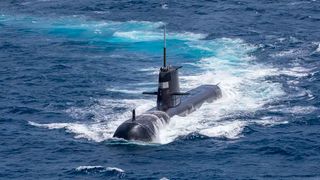Australia’s recent decision to acquire nuclear-powered submarines through the new Australia-United Kingdom-United States (AUKUS) defense technology partnership has put its efforts to deter China’s rising military power on the global stage. But as Australia’s 2020 Defence Strategic Update makes clear, China’s increasingly aggressive grey-zone coercion — the use of asymmetric tactics to achieve strategic goals without the overt use of military force — is eroding the Indo-Pacific order today. Unfortunately, Australia’s submarines won’t enter service until the late 2030s at the earliest. To effectively defend its security interests and shape the strategic environment in the interim, Canberra needs a more active strategy to deter China’s grey-zone coercion now. The United States and Australia should pursue this together.
Despite improved Australian and US efforts to punish Beijing’s malign activities and bolster collective resilience in the region, China remains undeterred beneath the threshold of armed conflict. It brushes aside multilateral efforts to expose its disinformation and cyber activities. Allied investments in Indo-Pacific resilience — including in health, infrastructure delivery, development assistance and maritime security — have not slowed China’s rapidly expanding strategic presence and willingness to coerce its neighbors. Freedom of navigation operations and aerial surveillance flights have done little to reduce Beijing’s appetite for risk in pressing its interests at the expense of Australia’s neighbors in the Pacific and Southeast Asia.
The most concrete example of the collective failure to confront China’s grey-zone activity is its geostrategic ascendency in the South China Sea, achieved via illegal land reclamation, unopposed military construction, and the use of coastguards and fishing militias to intimidate other countries into submission. Other asymmetric tactics by Beijing — such as cyberattacks, economic coercion, hostage diplomacy, information warfare, political interference, and the use of commercial actors for undeclared geopolitical activities — continue to erode a favorable balance of power and influence across the Indo-Pacific.
Unless willing nations actively stand up together, China’s grey-zone tactics will intensify and risk transforming the regional rules-based order into a Chinese sphere of influence. Australia and the United States have the potential to prevent this outcome and lead a counter-grey-zone campaign. But while there are signs of a more active approach emerging — like the nascent Quad leaders’ forum and burgeoning US and Australian initiatives to counter foreign interference — a more decisive, sustained, and coherent strategy is needed. Three principles should guide Canberra and Washington in this effort — a commitment to an active approach, unified purpose and effort, and the adoption of a new regional narrative.
Actively Regaining the Initiative
Australia and the United States need to regain the initiative by disrupting China’s grey-zone activities, posing their own grey-zone dilemmas, and being more willing to impose significant costs on China. But from the South China Sea to the South Pacific, both nations have been stuck in a reactive posture, responding to Beijing’s salami-slicing actions after the fact. This has ceded strategic momentum to China, with destabilising results for the region.
An active approach demands the creative use of existing military, intelligence, and economic levers now. It also requires the development of new, or upgraded, unorthodox capabilities that can complicate Chinese planning without attribution, in areas such as counter-space; deception; and information, seabed, and unconventional warfare. Compared to exquisite conventional weapons, including submarines, these options are comparatively cheap. Australian and US policymakers need to remember that asymmetric tactics are not the sole preserve of the aggressor. For instance, electronic disruption against Chinese collection operations, or building pockets of influence through proxies to quash future interference by China, are cost-effective ways to undercut Beijing’s business model. Imaginative thinking and a deep understanding of China’s vulnerabilities are the key requirements, underpinned by the right policy authorities and appetite for risk.
As part of this, Canberra and Washington should impose their own grey-zone dilemmas on China. This can be done in legal, moral, and ethical ways. The aim should be to force Chinese leaders to balance their grey-zone conduct against the risks of triggering escalation. This could involve efforts to create greater uncertainty for Beijing about the costs of crossing allied red lines. Revealing or feigning the existence of cutting-edge military capabilities may be a useful way to instill caution in China about pushing its luck. Targeted capacity-building efforts with key regional partners, like Indonesia and the Philippines, on ways to counter grey-zone tactics could challenge Chinese assumptions about the potential for collective military activity in maritime Southeast Asia. Proactive steps like these can help to put China on the back foot. Crucially, Canberra and Washington cannot assume that longstanding counter-terrorism training initiatives will sufficiently prepare regional friends for the sophistication of China’s grey-zone challenges.
Australia and the United States should also do more to empower maritime Southeast Asian countries to resist Chinese coercion and defend their own sovereignty. They should share more intelligence and domain awareness, step-up the frequency of combined patrols in contested parts of the region, and increase permanent liaison networks and capacity-building efforts. Embryonic trilateral Indonesian, Malaysian, and Filipino maritime, air, and land cooperation, for example, could benefit from these kinds of behind-the-scenes US and Australian efforts to assist these countries in more effectively protecting their own sovereign interests against Chinese infringements. Equally, the media, research institutions, and civil society actors with vested interests in pushing back against Chinese intimidation in Southeast Asia should be better supported to counteract Beijing’s influence.
Above all, Australia and the United States need to be more willing to impose costs on China that make its grey-zone aggression more difficult and dangerous. The Chinese Communist Party and other state institutions have considerable exposure outside of mainland China.
These have vulnerabilities and leverage points, as shown by revelations of Beijing’s use of corruption in Australian casinos to advance its United Front operations. As China has been willing to do itself, these weaknesses should be exploited when appropriate to force behavioural change, much as Australia responded to China’s recent attempts to gain military access in Vanuatu, Papua New Guinea, Fiji, and the Solomon Islands.
Unity of Purpose, Unity of Effort
If the alliance is to be a credible vehicle for combatting grey-zone coercion, Australia and the United States — working with other regional nations — should adopt a coherent and unified campaign approach. This should involve at least three elements.
First, both countries will need to assign clear roles and responsibilities between themselves. Resources and expertise are finite, and allies cannot afford to be at cross-purposes in ways that exacerbate seams and gaps for China to exploit. While Australia has recently stepped up engagement in the South Pacific, a simple geographic division of labour won’t be enough. Instead, Canberra should clearly communicate how it wants Washington to support its goal of building access and influence in Southeast Asia and the Pacific. In return, Washington should convey its expectations for more ambitious Australian leadership and resolve in the region, including a stronger and expanded Australian force posture and a willingness to provide deeper military, intelligence, and tactical support to frontline partners. Both allies should actively encourage close Japanese, Indian, Indonesian, and Singaporean involvement in their collective push-back on grey-zone activities.
How might this work in practice? In Jakarta’s mind, for example, Chinese provocations around the Natuna Islands and intelligence activities within Indonesian territorial waters are fermenting suspicions about Beijing’s intentions. While overt freedom-of-navigation demonstrations are not Jakarta’s style, China’s actions are creating openings for military-to-military collaboration with Australia and the United States that were previously inconceivable. Australian and US counter-terrorism agencies have closely partnered with the Indonesian police’s elite Densus 88 counter-terror squad since the early 2000s. These operations were highly successful, as the deadly raid on notorious Jemaah Islamiyah mastermind Noordin Mohammad Top publicly revealed in 2009. Drawing on such precedents, and where mutual interests align, Canberra and Washington could discreetly partner with select Indonesian military capabilities (like BAIS or Kopassus) to counter China’s grey-zone ambitions.
Second, Australia and the United States should agree on common red lines for high-impact scenarios, like a Chinese grey-zone escalation over Taiwan or a Ukraine-style “little green men” hybrid conflict in Southeast Asia or the Pacific. Clear red lines and agreed-on procedures for defending them are vital for deterring Chinese aggression, providing assurance to regional partners, and galvanising public support for the commitment in question. The two countries should begin by identifying what specific grey-zone actions — for example, cyberattacks against the critical infrastructure of a key regional partner — would constitute unacceptable behaviour, and proceed toward developing collective responses ahead of time. The US-Australia Indo-Pacific coordination mechanism established in 2019 could provide a starting point, particularly now that Australia appears willing to discuss thorny policy issues like Taiwan more frankly.
Third, orchestrating complex grey-zone or counter-grey-zone actions will involve more than the military. Canberra and Washington should knit together diplomatic, intelligence, economic, development assistance, and informational tools of statecraft. This coordination needs to happen inside the two countries’ respective agencies and bureaucracies, as well as between the Australian and US governments. A robust and real-time mechanism for integrating allied efforts is critical to avoid either missed opportunities for collective action or unhelpful duplication of effort. Such an undertaking goes beyond existing coordination mechanisms and requires the exploration of new alliance architecture.
A New Narrative
In working to take collective action and build relationships with regional partners, it is vital that the US-Australian alliance presents a positive and realistic vision of the future Indo-Pacific order. Traditional rhetoric about “upholding the rules-based order” or “ensuring a free and open Indo-Pacific” is insufficient to foster regional cohesion and incentivise collective action. Recent language about building a “world order that favors freedom” or winning a 21st-century struggle between autocracy and democracy risks being more divisive than useful in the region.
A new narrative should amplify nascent language on the centrality of sovereignty, domestic resilience, prosperity, and stability in the Indo-Pacific. It should underscore that grey-zone coercion poses a fundamental threat to these pillars of regional order. Although it should go beyond countering China to demonstrate allied commitments to regional priorities (such as terrorism, climate change, natural disasters, piracy, and illegal fishing), it should not shy away from identifying aspects of grey-zone coercion that warrant regional greater buy-in. Australian and US strategy documents are increasingly clear about these challenges. In addressing the above, the tone adopted by Canberra and Washington should accord with the interests and cultural norms of Southeast Asia and the Pacific.
One way to operationalise this narrative is for Australia and the United States to ground it in existing regional architecture and mechanisms. This would show the alliance is committed to regional priorities and enable greater cooperation with partners on pressing challenges that overlap with grey-zone coercion. For instance, Canberra and Washington could support the Jakarta Centre for Law Enforcement Cooperation to host training courses on how malign state actors corrupt legitimate avenues for regional influence or use transnational crime networks to undermine sovereignty. US and Australian assistance could increase the capacity of regional law enforcement to investigate and prosecute foreign interference, subversion, espionage, and cyber-based crimes, thereby deepening the region’s own resilience. Over time, the Counter-Terrorism Information Facility in Singapore could be supported in establishing a complementary platform for addressing coercion and disinformation challenges in Southeast Asia. Indeed, the Pacific Fusion Centre is already progressing down a similar path. In all these examples, US and Australian assistance should be delivered through a regionally led approach that respects local political considerations.
How Australia Can Do More
If Australia wants greater support from the United States, it will have to shoulder a greater share of the burden in countering Chinese coercion. Canberra has earned praise in US circles for implementing strong foreign interference and transparency laws, taking a hard stance on cyberattacks, resisting economic coercion, and questioning the veracity of China’s COVID-19 narrative. Its 2020 Defence Strategic Update has signaled Australia’s intent to counter grey-zone actions, though the government has been largely silent on what precisely this means.
In the wake of the AUKUS nuclear-powered submarine announcement, the time is ripe for Washington to ask Canberra to be more assertive. Indeed, it was apparently on the agenda at this year’s Australia-US ministerial 2+2 meeting (known as AUSMIN), though the sole reference to “work[ing] with partners to respond to ‘gray-zone’ activities” suggests little concrete progress was made. Militarily, the Australian Defence Force could focus on options to clandestinely operate against grey-zone threats and do more to prepare the Indo-Pacific operational environment for allied advantage. Given the relatively small size of Australia’s intelligence community — and its lack of an agency with a broad mandate like the CIA — this requires unorthodox military capabilities beyond legacy special operations forces. The United Kingdom’s Special Reconnaissance Regiment or its American equivalent offer inspiration towards this end. Indeed, countering Chinese coercion will require the Australian military to adopt modes of cooperation more familiar to intelligence and federal policing. The ways in which Australian agencies developed close operational relationships with partners for regional counter-terrorism in the 2000s and 2010s offer salient lessons that can be implemented for the task ahead.
Initiating a discreet military-to-military relationship with Taiwan could also yield payoffs. Taiwan has been dealing with Chinese grey-zone coercion for years, including in the South Pacific, making it an experienced and willing partner for Australia. Others, like Singapore and the United States, already engage Taiwan militarily and have done so for several decades without serious difficulties. There is nothing that should stop Australia from taking this step, given that its position on other issues, such as long-range strike and nuclear-powered submarines, already breaks with tradition and is becoming more risk-acceptant.
Finally, Canberra should adopt an even stronger voice in its neighborhood against Chinese propaganda. Chief of the Defence Force Gen. Angus Campbell argues that sunshine is “an extraordinarily powerful disinfectant.” This approach has been used to great effect inside Australia with regard to Chinese covert interference. It’s time to apply this principle more broadly in the region. Factual media operations, tailored to specific regional languages and platforms, should be employed to routinely expose Chinese grey-zone actions. This is best done independently by think tanks and research organisations that support allied objectives, and would be enhanced by deconfliction with US-run initiatives. While the Department of Foreign Affairs and Trade’s new counter-disinformation team is a good start, it’s far too small to have real region-wide impact and is under-resourced. Its efforts are also weakened — symbolically and substantively — by the shuttering of Australia’s development agency and regional public broadcaster Radio Australia.
No Time to Lose
Countering China’s grey-zone coercion will not be easy, especially when Australia and the United States are playing catch-up. But set against the expensive and long-term business of strengthening conventional Australian and US military capacity to deter Chinese aggression, playing in the grey-zone offers quick and tangible benefits. It can disrupt China’s present-day adventurism and preferred mode of regional expansion. And, if done well, it can develop the capabilities, influence networks, and regional cohesion that will be instrumental to military deterrence in the future.
The stakes for Australia and the United States could not be higher. If the alliance can adapt to the challenges of grey-zone competition, it will serve an increasingly valuable function in upholding the Indo-Pacific order and curtailing China’s coercive reach. If not, it will become irrelevant on one of the most important aspects of competition in the region, undermining allied security interests in the process. Strategic creativity and appetite for risk-taking will determine how successfully the US-Australian alliance rises to this challenge.






